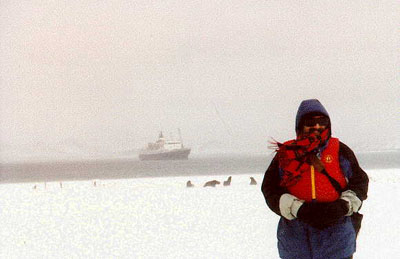
Crossing the Drake was just the beginning of our Antarctic adventure. We were in store for scenery beyond imagination and weather well outside the bounds of that experienced in Southern California. But Antarctica was only half our trip. The other half was at Iguazu National Park in Argentina and Brazil, and in Buenos Aires.
But why Antarctica?
Well, it seems we've started a pattern: for our 25th anniversary we did our first cruise -- the Inland Passage in Alaska. For our 30th, we did a cruise -- the Galapagos Islands and Ecuador. So, for our 35th, we wanted to do something really unusual. Maybe go where no one has gone beforeÖ.well, that's a bit extreme. But, maybe where only a relative small handful have gone before. So, why not an expedition to the end of the earth -- or the bottom: Antarctica. Why not indeed! And, as an added bonus, this would mean we've traveled to six continents and on three oceans!
With a destination selected, the focus shifted to arrangements. We had heard so much about Elderhostel and the quality of their programs, always with an educational component, that we investigated traveling with them (now that we're eligible with the approach of our more mature years). In September 2000 we put ourselves on the wait list (this trip filled fast, and you've got to be quick to get ahead of those seniors) and by mid-December we were notified that we'd be part of the 116 person party.
The Elderhostel group would assemble in Buenos Aires two days before the Antarctic portion began to enable the participates (who came from Europe, US, and Canada) to synchronize their jet lag and have a look around the city. As long as we had the airfare to Buenos Aires, we figured we might as well spend a little time learning about the gateway country. We came down a few days earlier to visit Iguazu National Park and the worlds second largest water falls. In total we ended up spending three nights at Iguazu, five nights in Buenos Aires, and eight nights on board our Antarctica explorer (the Lyubov Orlova, a converted Russian icebreaker). (The other two nights that we were gone were spent flying: it seems that all flights to and from Buenos Aires are red-eyes.)
 |
|
Lois took this picture of Jason on Deception Island, Latitude 62 degrees 59 minutes south of the equator on a lovely Antarctic summer day. The wonder of it all, with lots of layers of clothes, we were even warm! (Not bad for a couple of So Cal beach lovers.) And, its called Deception Island because its really the caldera of a still active volcano. Going around the outside it looks like any other island, expect for one spot where the walls have washed away and our ship was able to sail inside. If it weren't for the hoard frost (frozen fog) we would have pictures of the entire ring.
To sum Antarctica in a few words, its water in all its varied and
magnificent forms. We never knew water could be so awesome. Water
as ice, snow, icebergs, glaciers. Water as white caps, clouds,
mist, hoard frost, and rain. Water as blue, turquoise, black,
clear, and wet. Water below us, water above us, and water all
around us. Wonderful colorful water. Antarctica. Here we are in
front of a rather beautiful iceberg.
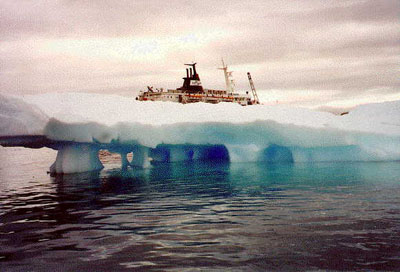 |
|
Antarctica is the highest, driest, coldest, windiest, heaviest,
and most dynamic continent on Earth. Only two percent is not
covered with ice (and those parts all seem vertical). During the
winter months (March - October) it almost doubles in size with the
frozen sea ice. During the summer months (November - February) it
is the home to penguins, seals, whales, and more penguins (and now
tourists). Lots of hungry penguin chicks.
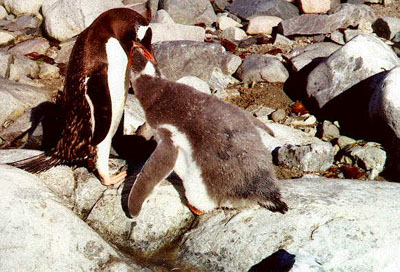 |
|
Although our Antarctic trip was only eight nights on board the Lyubov Orlova, so much was happening it seemed much longer. The first two days were crossing the Drake. Our three naturalists' lectures on Antarctic glaciers, sea birds, mammals, and history kept us engaged in-between our whale, penguin, and seal watches. The next three days included morning and afternoon shore trips. The last two were crossing the Drake, with the finale "rounding the Horn" (Cape Horn), and once again with lectures on Antarctica politics and the ozone hole.
The only way to get to Antarctica (for a realistic amount of money) is by sea. And the closest airport is in Ushuaia (pronounced ooh-swhy-uh), the southern most city in the world, located in Tierra del Fuego, Argentina. The ominous Cape Horn lies at the southern most tip of Tierra del Fuego, and is about 2700 miles further south than Cape of Good Hope in South Africa. (Click here for a map.) Most tourists fly into Ushuaia and then travel by ship to the Antarctic Peninsula.
The Drake Passage (named for Sir Francis Drake, who circumnavigated the world in 1577) is that strip of water which extends between South America and Antarctica. About midway is the Antarctic Convergence where the "colder" waters of the Southern (Antarctic) Ocean meet the "warmer" waters of the Atlantic and Pacific (and the Indian Ocean on the "other" side of the world). There are perpetual westerly winds making for waves and keeping the albatross constantly aloft.
At our welcome dinner our first night on board our expedition leader Shane shared this bit of wisdom:
"For those of you who know you get sea sick, take your medication starting now!Even though we're in the last category, we were sure glad we took along (and took) some Dramamine.
"For those of you who aren't sure if you get sea sick, take your medication starting now! And,
"For those of you who have never gotten sea sick, take your medication starting now!"
Our Drake crossings were both exhilarating, and exhausting. We were lucky with the trip south. Shane, our expedition leader, gave it a five on a ten point scale. In fact, we had such good weather and "smooth" sailing we reached the Peninsula a half day earlier than planned and got an extra shore visit (nice that it doesn't get dark until 10 PM). But, we had no such luck on the return trip ("More like an 8," said he). Climbing all those swells made the return a full day longer (for the same distance), and there was considerably more rock-and-roll.
The surge and tumble of the sea was just the beginning. Sea
birds, seals, whales, and dolphins kept us scanning the horizon as
we crossed those vast stretches of open water. Spectacular
glaciers and icebergs kept us transfixed as we skirted the coast
lines. Penguins (and the old whale bones which littered the
beaches) greeted us as came ashore.
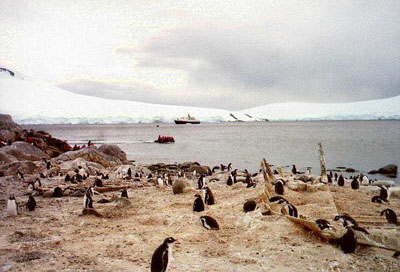 |
|
The daily schedule was roughly wake up call at 7:30, breakfast at
8, morning lectures/shore tours about 9:15, lunch at 12:30,
afternoon lectures/shore tours about 2, snack about 4:30, dinner
at 8, and evening Antarctic videos about 9:15. We had about 20
hours of daylight for our one cloudless night, but it got dark
much earlier when it was overcast. We had one grand sunset, and a
couple of just nice evening skies.
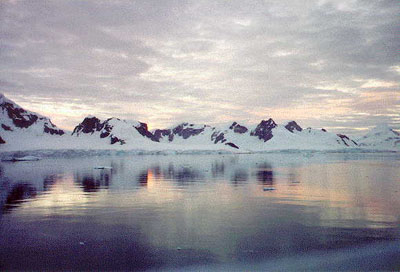

Our journeys ashore were via zodiacs, small rubber sided, hard
bottom boats which hold about 10 people. Since there were no
docks, we had wet landings, stepping (sliding) off the zodiacs
into about a foot of water (unless a swell caught you and then you
had a boot full!). The self-governing International Association of
Antarctica Tour Operators (IAATO) has set limits of 100 people at
a time on any landing, so we were divided into two groups of 60
and ferried ashore. The three naturalists always came ashore to
lead us around, identifying birds, penguins and seals, and
answering our questions. We had about two hours for each visit.
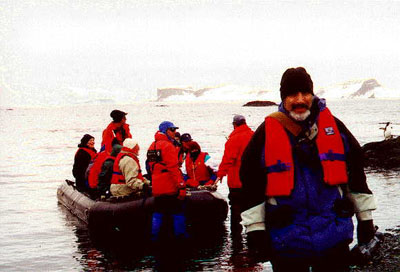 |
|
While one group was on shore, the second group took a zodiac tour
or had a lecture.
 |
|
Dressing to go ashore was an adventure in-and-of itself. We were
told to layer (two thins are better than one thick). Lois borrowed
Kevin's ski parka, and we ended up purchasing one for Jason (which
"fits" Stacy so it will have long term use!). They were wonderful.
We were told to purchase rubber work boots (about $15 at a
hardware store), and put lots of layers of socks. So,
typical dressing procedure: long johns/tights, jeans/sweat suit,
snowoveralls for the legs; undershirt, turtle neck, sweat shirt,
and parka (with hood) for the upper portion. A scarf and cap
crowned our crowns. And we were warm, even in the biting wind.
Temperatures weren't all that bad, ranging from about 0 to 40
degrees. Inspite of the cold, both sun glasses and sun block
were needed for all exposed areas (i.e., our nose and
cheeks). In fact, one night we had a barbecue on the poop
deck (at the usual 8:00 hour; temperature was in the 30s).
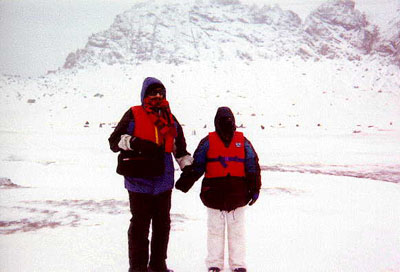 |
|
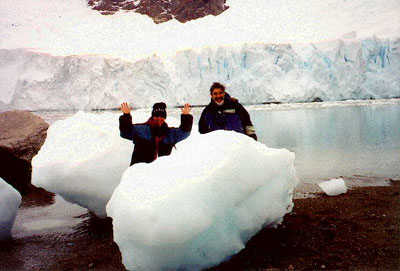 |
|
We ended up spending lots of time on the bridge and befriended
the chief mate. (There are no first mates on Russian ships, as
back in the days of the former Soviet Union, the first mate was
the "political officer," a seaman along to make sure everyone
towed the party line but who did not contribute to the operation
of the ship.) The chief mate encouraged us to come up for sunrise,
pointed out seals on icebergs (which Lois became exceptionally
good at spotting as they appeared like little dots), and answered
all our questions regarding the ship and navigation.
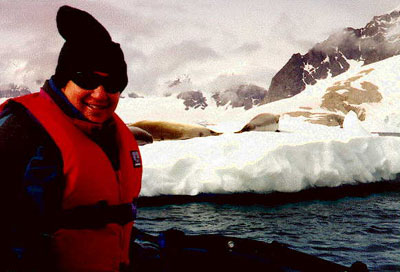 |
|
On our last night, as we rounded the Horn and headed for Ushuaia, Lois spotted our first dolphins of the trip, making it quite a complete experience. Our sail into Ushuaia at sunrise was very special, with grand snow covered mountains coming right down to the sea (that was all covered in fog on our departure).
Just a comment on our expedition party. Elderhostel is an organization which sets up educational programs for seniors. A few years ago they lowered the eligibility age to 55, and hence we could participate. We were among the youngest, but not the youngest in the tour. The most senior participant was a 92 year old gentleman, who, with canes and neck brace, went on every shore trip, attended every lecture, and told us after his n-th fall "I'm just practicing my falls until I perfect them!" His spirit was the norm for the group. And when we were hit by a rogue wave, and dozens of chairs when over in the dining room, people in their 60s, 70s, and 80s, got up, brushed themselves off, and went back to trying to get their sea legs. As one lady quipped: "If you came on this trip looking for the comforts of home, you should have just stayed at home." Participating with this group was as much a part of the thrill as Antarctica itself.
The topic of discussion on the return trip was preserving
Antarctica for future generations. There is no government in
Antarctica, and only a treaty for which participants agree not to
defile the continent. But Antarctica is rich in natural resources
(it was once part of Africa before the plates moved it south) and
a fabulous tourist attraction. Currently the Drake Passage is also
the "Drake Barrier," a major impediment to visiting or exporting
resources. However, that "barrier" didn't stop the whalers who
hunted some seals and whales to the edge of extinction. If someone
wants to build an airport to shuttle in tourist, or exploit the
mining and fishing opportunities, there is no one to stop them.
These are major challenges facing Antarctica. We were truly
fortunate to be able to learn and see first hand the awesome
beauty and pristine lands.
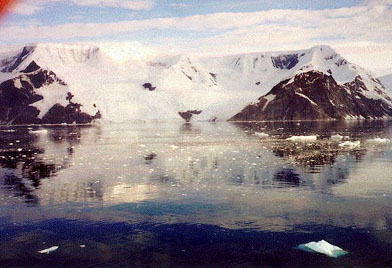 |
|
In all, oh, what an exciting, beautiful, challenging,
exhilarating adventure -- far more than a "trip" -- a real
expedition to the Southern Continent: Antarctica.